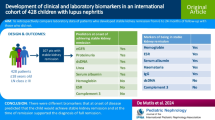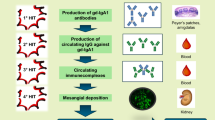Abstract
The aim of this study was to evaluate the expression of human T cell immunoglobulin domain and mucin-3 (Tim-3) in renal tissue from patients with immunoglobulin A nephropathy (IgAN) and without IgAN and to evaluate the difference in Tim-3 expression between them. A total of 71 patients with IgAN as IgA group and 13 patients without IgAN as control group were enrolled in the present study. Patients in IgAN accepted percutaneous renal biopsy. We examined the expression of Tim-3 in renal tissue and the serological parameters in serum from all enrolled cases. The expression of Tim-3 and serological parameters were compared between the different groups. Positive staining of Tim-3 protein was seen in 94.3 % patients with IgAN (67 out of 71), but only 15.4 % (2 out of 13) in the cases without IgAN were positive staining of Tim-3. There were significant differences between two groups in almost all serological markers, which reflect IgAN activity. There was a nearly positive correlation between pathological manifestations and expression degree of Tim-3. High immuno-reactivity of Tim-3 was found to be significantly correlated with serological grade (p < 0.001) in IgA group, but there was no such phenomenon in control group. The results showed that there was the expression of Tim-3 in renal tissue from the patients with IgAN, but rarely expression in cases without IgAN. Expression of Tim-3 was associated with the diseases’ activity.

Similar content being viewed by others
References
Lin HL, Lin HC, Chen YH. Increased risks of Parkinsonism in the 3 years after chronic renal failure. Int J Clin Pract. 2012;66(5):499–503.
Mubarak M. Oxford classification of IgA nephropathy: broadening the scope of the classification. J Nephropathol. 2012;1:13–6.
Nasri H, Madihi Y, Merrikhi A, Gheissari A, Baradaran A, Kheiri S, et al. Association of proteinuria with various clinical findings and morphologic variables of Oxford classification in immunoglobulin A nephropathy patients. Int J Prev Med. 2013;4(5):546–51.
Takechi H, Oda T, Hotta O, Yamamoto K, Oshima N, Matsunobu T, et al. Clinical and immunological implications of increase in CD208+ dendritic cells in tonsils of patients with immunoglobulin A nephropathy. Nephrol Dial Transpl. 2013;28(12):3004–13.
Lu B, Chen L, Liu L, Zhu Y, Wu C, Jiang J, et al. T-cell-mediated tumor immune surveillance and expression of B7 co-inhibitory molecules in cancers of the upper gastrointestinal tract. Immunol Res. 2011;50(2–3):269–75.
Guo L, Yang X, Xia Q, Zhen J, Zhuang X, Peng T. Expression of human T-cell immunoglobulin domain and mucin-3 (Tim-3) on kidney tissue from systemic lupus erythematosus (SLE) patients. Clin Exp Med. 2013. doi:10.1007/s10238-013-0264-3.
Kurose Y, Wada J, Kanzaki M, Teshigawara S, Nakatsuka A, Murakami K, et al. Serum galectin-9 levels are elevated in the patients with type 2 diabetes and chronic kidney disease. BMC Nephrol. 2013;22(14):23. doi:10.1186/1471-2369-14-23.
Wyatt RJ, Julian BA. IgA nephropathy. N Engl J Med. 2013;368(25):2402–14.
Floege J, Eitner F. Current therapy for IgA nephropathy. J Am Soc Nephrol. 2011;22:1785–94.
Li Z, Ju Z, Frieri M. The T-cell immunoglobulin and mucin domain (Tim) gene family in asthma, allergy, and autoimmunity. Allergy Asthma Proc. 2013;34(1):e21–6.
Wang Y, Liu ZL, Sun J, Ilham I, Hu HF, Zhang H. Relationship between polymorphism sites of Tim-3 and allergic rhinitis in a population of Uigurs and Hans from Xinjiang Uigur Autonomous Region of China. Zhonghua Er Bi Yan Hou Tou Jing Wai Ke Za Zhi. 2011;46(9):712–7.
Li WX, Chen GM, Yuan H, Yao YS, Li RJ, Pan HF, et al. Polymorphisms of the Tim-1 and Tim-3 genes are not associated with systemic lupus erythematosus in a Chinese population. Mutagenesis. 2011;26(4):507–11.
Cao Y, Zhou X, Huang X, Li Q, Gao L, Jiang L, et al. Tim-3 expression in cervical cancer promotes tumor metastasis. PLoS ONE. 2013;8(1):e53834.
Weichert W, Denkert C, Schmidt M, Gekeler V, Wolf G, Köbel M, et al. Polo-like kinase isoform expression is a prognostic factor in ovarian carcinoma. Br J Cancer. 2004;90(4):815–21.
Lee HS, Lee MS, Lee SM, Lee SY, Lee ES, Lee EY et al. Histological grading of IgA nephropathy predicting renal outcome: revisiting H. S. Lee’s glomerular grading system. Nephrol Dial Transpl. 2005; 20(2):342–8.
Seki M, Oomizu S, Sakata KM, et al. Galectin-9 suppresses the generation of Th17, promotes the induction of regulatory T cells, and regulates experimental autoimmune arthritis. Clin Immunol. 2008;127:78–88.
Du WT, Zhao HF, Xu JH, Gu DS, Xue F, Ge J, et al. The role of T-cell immunoglobulin- and mucin-domain-containing molecule-3 polymorphisms in idiopathic thrombocytopenic purpura. Hum Immunol. 2009;70(6):398–402.
Chae SC, Park YR, Shim SC, Yoon KS, Chung HT. The polymorphisms of Th1 cell surface gene Tim-3 are associated in a Korean population with rheumatoid arthritis. Immunol Lett. 2004;95(1):91–5.
Lim CS, Zheng S, Kim YS, Ahn C, Han JS, Kim S, et al. Th1/Th2 predominance and proinflammatory cytokines determine the clinicopathological severity of IgA nephropathy. Nephrol Dial Transpl. 2001;16(2):269–75.
Hurtado A, Johnson RJ. Hygiene hypothesis and prevalence of glomerulonephritis. Kidney Int Suppl. 2005;97:S62–7.
Li WX, Chen GM, Yuan H, Yao YS, Li RJ, Pan HF, et al. Polymorphisms of the Tim-1 and Tim-3 genes are not associated with systemic lupus erythematosus in a Chinese population. Mutagenesis. 2011;26(4):507–11.
Lee HS, Lee MS, Lee SM, Lee SY, Lee ES, Lee EY, et al. Histological grading of IgA nephropathy predicting renal outcome: revisiting H. S. Lee’sglomerular grading system. Nephrol Dial Transpl. 2005;20(2):342–8.
Acknowledgments
This study was supported by Shandong Province Outstanding Young Scientist Research Award Fund Project, NO. BS2013YY042. Natural Science Foundation of Shandong Province, No. ZR2013HM106. All authors express their appreciation to the enrolled patients.
Conflict of interest
None.
Author information
Authors and Affiliations
Corresponding author
Rights and permissions
About this article
Cite this article
Yang, X., Hu, Z., Xia, X. et al. Expression of human T cell immunoglobulin domain and mucin-3 on kidney tissue from immunoglobulin A nephropathy patients. Immunol Res 60, 85–90 (2014). https://doi.org/10.1007/s12026-014-8550-z
Published:
Issue Date:
DOI: https://doi.org/10.1007/s12026-014-8550-z




